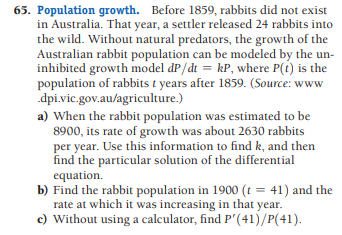65. Population growth. Before 1859, rabbits did not exist in Australia. That year, a settler released 24 rabbits into the wild. Without natural predators, the growth of the Australian rabbit population can be modeled by the un- inhibited growth model dP/dt = kP, where P(t) is the population of rabbits t years after 1859. (Source: www dpi.vic.gov.au/agriculture.) a) When the rabbit population was estimated to be 8900, its rate of growth was about 2630 rabbits per year. Use this information to find k, and then find the particular solution of the differential equation. b) Find the rabbit population in 1900 (t = 41) and the rate at which it was increasing in that year. c) Without using a calculator, find P'(41)/P(41).
65. Population growth. Before 1859, rabbits did not exist in Australia. That year, a settler released 24 rabbits into the wild. Without natural predators, the growth of the Australian rabbit population can be modeled by the un- inhibited growth model dP/dt = kP, where P(t) is the population of rabbits t years after 1859. (Source: www dpi.vic.gov.au/agriculture.) a) When the rabbit population was estimated to be 8900, its rate of growth was about 2630 rabbits per year. Use this information to find k, and then find the particular solution of the differential equation. b) Find the rabbit population in 1900 (t = 41) and the rate at which it was increasing in that year. c) Without using a calculator, find P'(41)/P(41).
Chapter5: Exponential And Logarithmic Functions
Section5.5: Exponential And Logarithmic Models
Problem 30E: The table shows the mid-year populations (in millions) of five countries in 2015 and the projected...
Related questions
Question

Transcribed Image Text:65. Population growth. Before 1859, rabbits did not exist
in Australia. That year, a settler released 24 rabbits into
the wild. Without natural predators, the growth of the
Australian rabbit population can be modeled by the un-
inhibited growth model dP/dt = kP, where P(t) is the
population of rabbits t years after 1859. (Source: www
dpi.vic.gov.au/agriculture.)
a) When the rabbit population was estimated to be
8900, its rate of growth was about 2630 rabbits
per year. Use this information to find k, and then
find the particular solution of the differential
equation.
b) Find the rabbit population in 1900 (t = 41) and the
rate at which it was increasing in that year.
c) Without using a calculator, find P'(41)/P(41).
Expert Solution
This question has been solved!
Explore an expertly crafted, step-by-step solution for a thorough understanding of key concepts.
This is a popular solution!
Trending now
This is a popular solution!
Step by step
Solved in 4 steps

Recommended textbooks for you


Functions and Change: A Modeling Approach to Coll…
Algebra
ISBN:
9781337111348
Author:
Bruce Crauder, Benny Evans, Alan Noell
Publisher:
Cengage Learning

Glencoe Algebra 1, Student Edition, 9780079039897…
Algebra
ISBN:
9780079039897
Author:
Carter
Publisher:
McGraw Hill


Functions and Change: A Modeling Approach to Coll…
Algebra
ISBN:
9781337111348
Author:
Bruce Crauder, Benny Evans, Alan Noell
Publisher:
Cengage Learning

Glencoe Algebra 1, Student Edition, 9780079039897…
Algebra
ISBN:
9780079039897
Author:
Carter
Publisher:
McGraw Hill

Algebra & Trigonometry with Analytic Geometry
Algebra
ISBN:
9781133382119
Author:
Swokowski
Publisher:
Cengage
